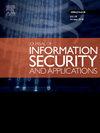在全同态加密中利用可自学习的激活函数加强隐私保护机器学习
IF 3.8
2区 计算机科学
Q2 COMPUTER SCIENCE, INFORMATION SYSTEMS
Journal of Information Security and Applications
Pub Date : 2024-09-23
DOI:10.1016/j.jisa.2024.103887
引用次数: 0
摘要
在人工智能和数据工程领域,有效利用数据对于提高各行各业的生产力至关重要。随着机器学习越来越依赖敏感数据,如何平衡隐私与计算效率已成为一大挑战。同态加密在机器学习中既能对加密数据进行计算,又能保护隐私,是一种很有前景的解决方案。然而,它与神经网络的整合受到了高计算需求和执行复杂非线性操作的限制的阻碍。为了应对这些挑战,我们提出了一种新方法,其中包含 "自学习激活函数"(SLAF),并改进了神经网络线性层的结构。我们的优化神经网络模型专为生物识别身份验证任务量身定制,其性能优于使用简单多项式激活函数的传统方法。UTKFace数据集包含了不同场景下的面部特征,我们利用该数据集验证了我们的解决方案在实际应用中的有效性。实验结果表明,与传统模型相比,准确率提高了 0.88% 至 3.15%,与 CryptoNets 模型相比,准确率提高了 4.87% 至 9.67%,这表明我们的方法能够满足严格的隐私保护生物识别认证要求。本文章由计算机程序翻译,如有差异,请以英文原文为准。
Enhancing privacy-preserving machine learning with self-learnable activation functions in fully homomorphic encryption
In the field of artificial intelligence and data engineering, the effective utilization of data is critical for improving productivity across various sectors. As machine learning increasingly relies on sensitive data, balancing privacy with computational efficiency has become a major challenge. Homomorphic encryption provides a promising solution by enabling computation on encrypted data while preserving privacy in machine learning. However, its integration with neural networks is hindered by high computational demands and limitations in performing complex nonlinear operations. To address these challenges, we propose a novel approach that incorporates a ”Self-Learnable Activation Function” (SLAF) and refines the structure of neural network linear layers. These enhancements are designed to accommodate the constraints of homomorphic encryption, allowing for deeper network architectures without significant computational overhead.
Our optimized neural network model, tailored for biometric authentication tasks, outperforms traditional methods that use simple polynomial activation functions. Using the UTKFace dataset, which includes facial features under diverse scenarios, we validated the effectiveness of our solution in real-world applications. Experimental results demonstrate accuracy improvements of 0.88% to 3.15% over traditional models and 4.87% to 9.67% over the CryptoNets model, underscoring the capability of our approach to meet stringent privacy-preserving biometric authentication requirements.
求助全文
通过发布文献求助,成功后即可免费获取论文全文。
去求助
来源期刊

Journal of Information Security and Applications
Computer Science-Computer Networks and Communications
CiteScore
10.90
自引率
5.40%
发文量
206
审稿时长
56 days
期刊介绍:
Journal of Information Security and Applications (JISA) focuses on the original research and practice-driven applications with relevance to information security and applications. JISA provides a common linkage between a vibrant scientific and research community and industry professionals by offering a clear view on modern problems and challenges in information security, as well as identifying promising scientific and "best-practice" solutions. JISA issues offer a balance between original research work and innovative industrial approaches by internationally renowned information security experts and researchers.
 求助内容:
求助内容: 应助结果提醒方式:
应助结果提醒方式:


